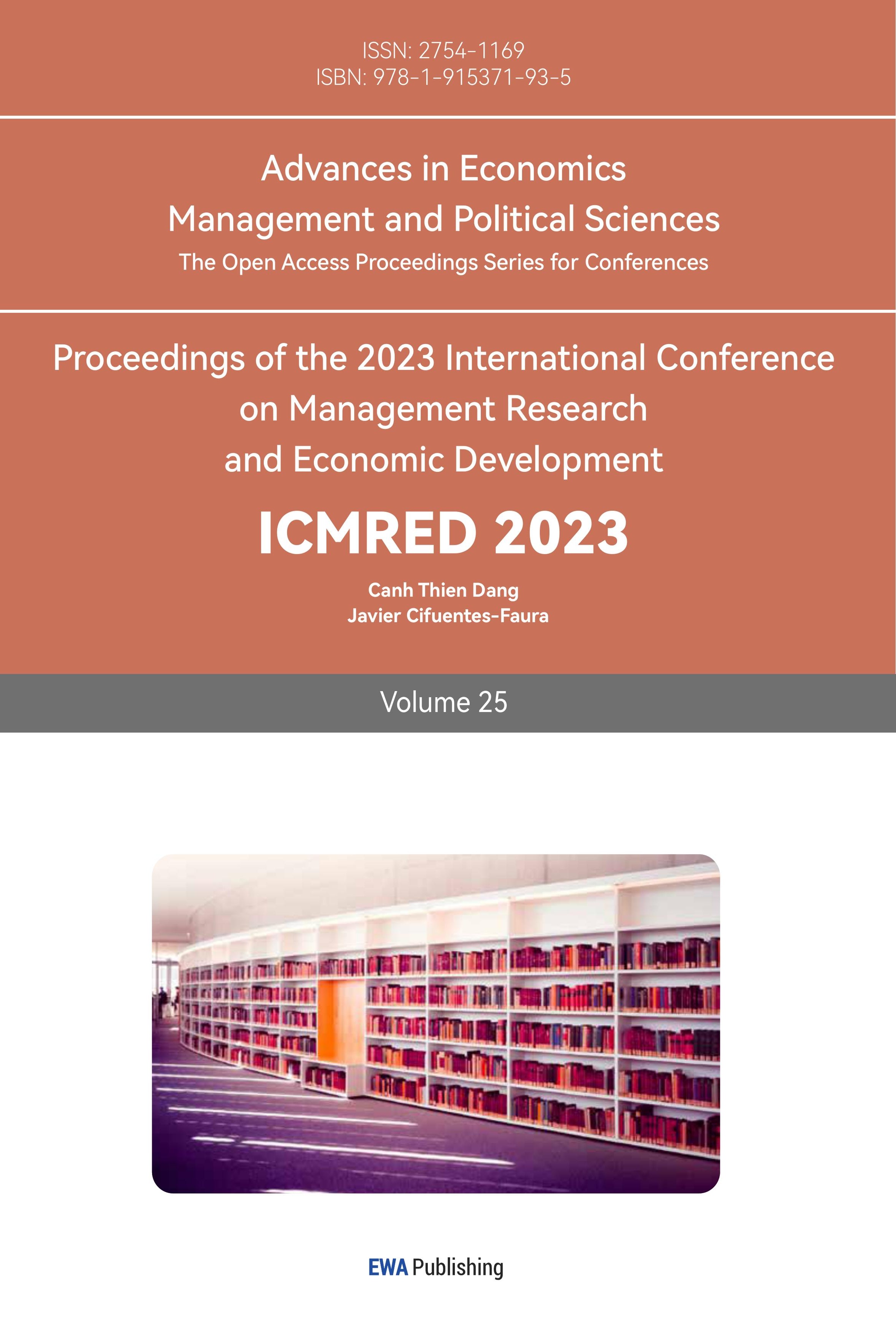References
[1]. Chai Jian, Extraction of Core Influencing Factors of China's Income Gap and Research on Nonlinear Dynamic Impact Effects, Contemporary Economic Science, 2023-01-16, 74
[2]. Cheng Mingwang, Urban Rural Income Gap and Common Prosperity, Financial and Trade Research, October 15, 2022-15,8
[3]. Yu Yongze, Digital Economy and Common Prosperity: An Analysis Based on the Income Gap between Urban and Rural Areas in China, Journal of Lanzhou University of Finance and Economics, February 10, 2023,4.
[4]. Li Jiaming, Research on the Distribution of Living Expenses among College Students, Labor and Social Security World, 2019-01-20,283
[5]. Jiang Tuanbiao, Fiscal Bias, Rural Labor Transfer, and Urban Rural Income Gap, Journal of Agriculture and Forestry Economic Management, 2023-07-2,2
[6]. Peng Dingyi, Research on the Changing Law and Convergence of China's Industry Income Gap, Finance and Accounting Communication, 2022-08-11,1.
[7]. Shi Jifan, Exploring the Differences in Consumption Concepts between Urban and Rural Residents in China, Fortune Today, December 5, 2018,61
[8]. Zang Xiaoqing, Basis and Path Selection for Reducing the Gap between the Rich and the Poor -- Starting from the Gini Coefficient Paradox, Financial Theory Research, 2022-11-05,17.
Cite this article
Zhao,G. (2023). Research on the Family Income Gap in China. Advances in Economics, Management and Political Sciences,25,344-348.
Data availability
The datasets used and/or analyzed during the current study will be available from the authors upon reasonable request.
Disclaimer/Publisher's Note
The statements, opinions and data contained in all publications are solely those of the individual author(s) and contributor(s) and not of EWA Publishing and/or the editor(s). EWA Publishing and/or the editor(s) disclaim responsibility for any injury to people or property resulting from any ideas, methods, instructions or products referred to in the content.
About volume
Volume title: Proceedings of the 2023 International Conference on Management Research and Economic Development
© 2024 by the author(s). Licensee EWA Publishing, Oxford, UK. This article is an open access article distributed under the terms and
conditions of the Creative Commons Attribution (CC BY) license. Authors who
publish this series agree to the following terms:
1. Authors retain copyright and grant the series right of first publication with the work simultaneously licensed under a Creative Commons
Attribution License that allows others to share the work with an acknowledgment of the work's authorship and initial publication in this
series.
2. Authors are able to enter into separate, additional contractual arrangements for the non-exclusive distribution of the series's published
version of the work (e.g., post it to an institutional repository or publish it in a book), with an acknowledgment of its initial
publication in this series.
3. Authors are permitted and encouraged to post their work online (e.g., in institutional repositories or on their website) prior to and
during the submission process, as it can lead to productive exchanges, as well as earlier and greater citation of published work (See
Open access policy for details).
References
[1]. Chai Jian, Extraction of Core Influencing Factors of China's Income Gap and Research on Nonlinear Dynamic Impact Effects, Contemporary Economic Science, 2023-01-16, 74
[2]. Cheng Mingwang, Urban Rural Income Gap and Common Prosperity, Financial and Trade Research, October 15, 2022-15,8
[3]. Yu Yongze, Digital Economy and Common Prosperity: An Analysis Based on the Income Gap between Urban and Rural Areas in China, Journal of Lanzhou University of Finance and Economics, February 10, 2023,4.
[4]. Li Jiaming, Research on the Distribution of Living Expenses among College Students, Labor and Social Security World, 2019-01-20,283
[5]. Jiang Tuanbiao, Fiscal Bias, Rural Labor Transfer, and Urban Rural Income Gap, Journal of Agriculture and Forestry Economic Management, 2023-07-2,2
[6]. Peng Dingyi, Research on the Changing Law and Convergence of China's Industry Income Gap, Finance and Accounting Communication, 2022-08-11,1.
[7]. Shi Jifan, Exploring the Differences in Consumption Concepts between Urban and Rural Residents in China, Fortune Today, December 5, 2018,61
[8]. Zang Xiaoqing, Basis and Path Selection for Reducing the Gap between the Rich and the Poor -- Starting from the Gini Coefficient Paradox, Financial Theory Research, 2022-11-05,17.









